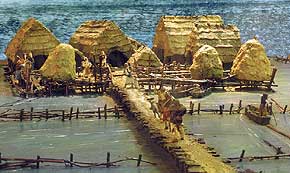|
15th |
WIGRY NATIONAL PARK
|
|||
|
of "WIGRY"
|
Maciej Ambrosiewicz
Cultural heritage of the Wigry National Park
The Wigry National Park was founded to protect high natural values as well as its landscape and cultural values. The oldest archaeological findings proving man habitation on Lake Wigry date back to the Late Paleolithic Age (the Old Stone Age), that is more than 12, 000 years ago. They are flint stone relicts that are the remnants of the cultures, which appeared on this terriotory migrating along with reindeer herds changing habitat due to climate changes of that time. The significant turn of history of north-east Poland took place at the beginning of the Iron Age in the middle of 6th century B.C., when Balt tribes originating from the River Dnepr basin reached the region.
As a result of the third partition of Poland the area neighbouring Lake Wigry was annexed by Prussia. Prussian authorities confiscated church properties. After 1815 this part of land was annexed by Russia and included into the Congress Kingdom of Poland. Gradual colonization started in government owned estates, and then peasants started to be charged with the rent, and land integration was initiated. The colonization of the area surrounding Lake Wigry was completed in the middle of the 19th century, and the settlement network formed up to that time have survived up to present day with only slight changes. Contemporary settlement is only of rural character and is only marginally connected with forest economy.
In the Middle Ages (7th–13th century) the discussed region was inhabited by the Jatvings – one of the Western Balt tribes. After the decline of the Jatvings the vicinity of Lake Wigry was uninhabited for almost two centuries. The exploitation of primeval forest resources started in the times of the Grand Dukes of Lithuania rule, that is in the 15th century. The activity of the Cameldolites order was essential for the settlement in Lake Wigry surroundings. The order was granted with Wigry Peninsula in 1667 by decision of Jan Casimir the Second. At first, the Cameldolities tried to attract settlers to existing iron (so-called rudnia, from Polish ruda – ore), glass, charcoal, wood tar and turpentine.
Traditional folk architecture of the surroundings of Lake Wigry is typical of the entire Suwalki Region. It is characterised by an array of building layouts, serving diverse functions. Various materials are used and there is a wealth of ornamental detail. The influence of the rural architecture of the neighbouring Masuria and Lithuania is clearly visible. Forest architecture forms another interesting group. A few buildings from the inter-war period have survived in the Wigry National Park. Many traditional buildings require conservation. Their condition is often rather poor and there is the threat that they may vanish from rural landscapes of Lake Wigry.
|
|||
|
|
|




